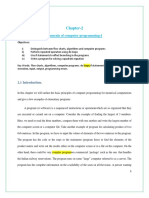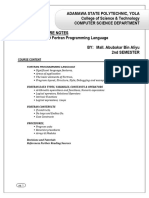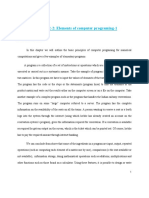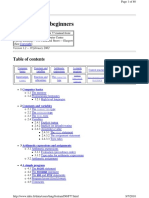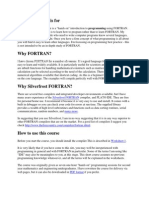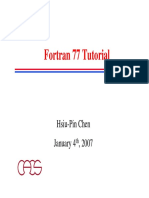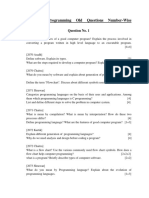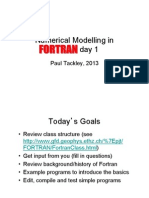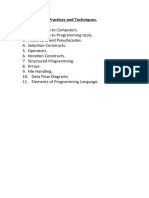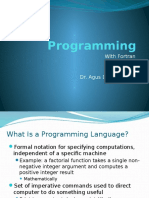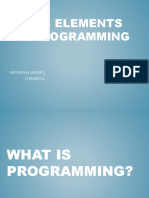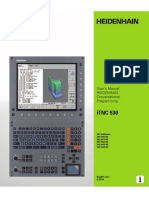FORTRAN Programming Questions (Reorganized by Topic)
I. Fundamentals and Concepts
• What is meant by the word FORTRAN?
• What is the function of FORTRAN compiler?
• How many types of data are used in FORTRAN?
• What is variable in FORTRAN?
• Why stop statement is used in a program?
• Write down the structure of GOTO statement in FORTRAN.
• How many types of numeric constants used in FORTRAN? What are they?
• How many types of Sub-programs in FORTRAN and what are they?
• Discuss the different structures of algorithms used in the FORTRAN language.
• Write down the character set used in FORTRAN programming.
• What is constant? Discuss different types of constant in FORTRAN.
• What is an "executable statement"? Distinguish between 'STOP' statement and 'END' statement.
• Give a list of characters used in FORTRAN language.
• Explain why the following words are not valid as FORTRAN variables: (i) INPUT; (ii) 26 MARCH; (iii)
CPMputer; (i) X-RAY; (ii) STOP; (iii) 4 YEAR; (iv) IF.
• Array-subscripted variable. What is subscripted-variable? Discuss with examples.
• Executable statement. Write down the difference between Stop statement and End statement.
• Describe the data types used in FORTRAN language with examples.
• Discuss the operators used in FORTRAN language with example.
II. Control Structures (IF, GOTO, DO Loops)
• What is Conditional statement? Explain conditional statement in FORTRAN.
• Explain Nested DO Loop with example.
• Describe the logic structures used in FORTRAN programming.
• What does the control statement mean? Describe the 'if' statement with a flowchart.
• Illustrate the IF-THEN, IF-THEN-ELSE and GOTO statements with examples.
• What is the general form of Do statement? Explain Do-loop and nested Do-loops with examples.
• Describe the construction and use of various types of IF statement.
• Write down the rules to be followed in DO loop.
• Describe different types of transfer statements with examples.
• What do you mean by 'IF' statement in FORTRAN? Describe the construction of various 'IF'
statements.
• Describe Do loop and Nested Do loop with example.
• What is IF statement? Describe IF-THEN, IF-THEN-ELSE and GOTO statements with examples.
III. Subprograms (Functions and Subroutines)
• What is sub-routine? Discuss role of call statement to invoke a sub-routine.
• What is subprogram? Write down the differences between FUNCTION subprogram and SUBROUTINE
subprogram.
• Define sub program. Write down the rules for writing function sub program.
• Distinguish between FUNCTION subprogram and SUBROUTINE subprogram.
1
� • Define sub-program. Write the rules for writing function sub-program.
IV. Mathematical Expressions and Built-in Functions
• Explain the functions of the following library functions with examples: MOD( ), SQRT( ), FLOAT( ),
EXP( ).
• Illustrate the following library functions: ABS, MOD, EXP, IFIX, SORT.
• Express the following equations in the form of FORTRAN statement:
• (i) CV = SDX × 100
• (ii) Z = sin^-1(X + |Y|)
• (iii) Y = (1/sqrt(2*pi)) * e^(-1/2 * ((x - mu)/sigma)^2)
• (iv) p = sin(x - 2y) + e^y - |x^2|
• (v) q = a^2 - b^2 + c^2 * sin(x + y)
• (vi) r = ((a^2 + b^2 * ab + ba) * (a + b^2 * a + b1))
V. Programming Problems and Examples
• Coding the following mathematical expressions in Fortran:
• (i) If A > B, stop
• (ii) If X = Y + 3, go to the statement labelled 25
• Suppose J and K have the values 3 and 5 respectively. Find the final value of J after each program
segment.
• Write a FORTRAN program which will read a set of numbers x1, x2, … and will display the value of
their arithmetic mean, variance and standard deviation.
• Write a FORTRAN program with necessary sub-programs to determine the multiplication of two
matrices.
• Write a Fortran program to calculate the standard deviation and the coefficient of variation of a
given data set.
• Write a Fortran program to calculate the probability of a normal distribution.
• Write a FORTRAN program with a flowchart to determine whether an integer number is even or odd.
• Write a FORTRAN program with necessary subprogram to determine the probabilities of a negative
binomial distribution.
• Develop a program in FORTRAN language to obtain the mean and standard deviation of a set of
observations.
• Draw a flow-chart and write FORTRAN program which calculates:
• (i) 2^3 + 4^6 + 24^23
• (ii) 3^1 + 5^1 + … + 25^1
• Write a FORTRAN program to find out the largest number from three numbers X, Y, Z.
• Write a FORTRAN program with necessary sub-program for binomial distribution.
• Suppose an amount of Tk. 50,000 is deposited in a savings account in 2001 and suppose the bank
pays 6% interest on the account compounded annually. Write a program which prints the YEAR and
the AMOUNT of the account until 2015.
Basic Computer Language Concepts (Reorganized by Topic)
I. Core Concepts of Programming
• What is called programming language?
2
� • What is the function of a compiler?
• What is an object program?
• Define library function.
• What do you mean by computer programming?
• What is meant by algorithm?
• Define Object with example.
• What is subprogram?
• What is input and output statement?
• What do you mean by mixed mode operation?
• What is 'bug'?
• What is dimensioned variable?
• What is called Arrays?
• What is DATA statement?
• What is debugging?
• What is Coding?
II. Algorithms and Flowcharts
• What is flowchart?
• What do you mean by loop?
• What do you mean by source program?
• What is Concatenation operator?
• What is called executable statement?
• What do you mean by 'input' statement?
• Define flowchart.
• What do you mean by run time error?
• What facilities do a repetitive structure give to a programmer?
• Write the functions of SUB-ROUTINE sub-program.
• How to recall and correction of previous commands?
• When an expression does not store in memory of a computer?
• What is flowchart? Write down the functions of the symbols used in flowchart.
• Define flow chart in programming. Write the uses of flow chart.
• Write down the steps in solving a problem in computer programming.
III. Programs & Software
• What is a program? Write down the important features of an ideal program.
• What is software? Write down the features of an ideal program.
• What is computer programming? Mention the important points to select language in writing a
computer program.
IV. Exam-Type Questions
• Describe machine language and high-level language.
• Write the differences between an interpreter and a compiler.
• Define and classify programming language.
• What do you mean by source program and object program?
• Distinguish between machine language and high level language.
3
�• Draw a flowchart to calculate the real roots of a quadratic equation.
• What is called an algorithm? Write down the properties of a good algorithm.
• Describe the required steps for solving a mathematical problem by computer programming.
• Explain the symbols used in flowchart.
• Draw a flowchart to determine the real roots of a quadratic equation.
• What do you mean by algorithm and flowchart? Write down the characteristics of an ideal algorithm.
• Describe various transfer statements with example.
• Write an algorithm and draw a flow chart to determine the roots of the equation ax^2 + bx + c = 0.
• Define algorithm and flow-chart of a program to solve a problem.


